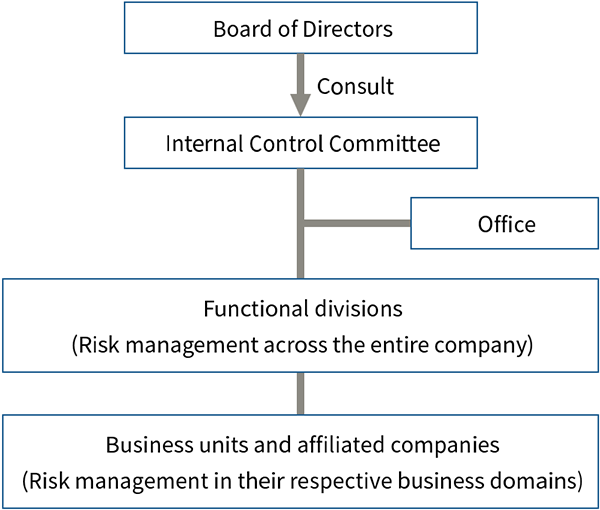Risk Management
Risk Management
| Fiscal 2024 Objectives | Fiscal 2024 Achievements | Self-Evaluation | Priority Objectives for Fiscal 2025 |
|---|---|---|---|
|
|
★★ |
|
- Self-evaluation: ★★★ Achieved more than targeted / ★★ Achieved as targeted / ★ Achieved to some extent
Basic Approach to Risk Management
Sharp positions risk management as one its most important efforts in fulfilling corporate social responsibility, which entails meeting the expectations of stakeholders through the sustainable development of business.
Sharp is building a business risk management system based on its Rules of Business Risk Management. As well, we have identified and are managing a total of 118 specific risks that could have a major impact on management. These are classified into five categories: external business environment, financial, legal, labor, and business activities.
For each specific risk, functional divisions responsible for risk management across the entire company and business units and affiliated companies responsible for risk management in their respective business domains collaborate to minimize risks and to prevent risks from actually occurring.
To keep up with changes in the business environment and market, we annually revise, evaluate, and grade specific risks. The goal is to prevent them from occurring and to study and formulate responses should these risks occur. The formulated responses are reviewed by the general manager of the Finance and Administration Office and reported to the Internal Control Committee, which is chaired by the president & CEO. Reports to the Internal Control Committee include overviews of and countermeasures to the below-mentioned major risk incidents, and their numbers. The content of reports to the Internal Control Committee is also relayed to the Board of Directors.
Business Risk Management System

Number of Specific Risks and Their Classification (As of May 2025)
| Classification | Example of Specific Risks | Number of Risks |
|---|---|---|
| External business environment | Natural disasters, infectious diseases | 12 |
| Financial | Finance-related risks | 13 |
| Legal | Breaking laws or rules, business-related scandals | 31 |
| Labor | Problems related to hiring of employees, labor management, and human rights | 14 |
| Business activities | Problems related to products, services, quality, material procurement, confidential information leaks, the environment | 48 |
| 118 | ||
Response to Occurrence of Major Risks
The Rules of Business Risk Management prescribe rules for response if a major risk incident does come to pass. Taking prompt and appropriate action when an emergency situation occurs works to minimize loss and to prevent the damage from spreading not only across the company, but also to society at large. These emergency rules also specify action items to be implemented to ensure prompt and appropriate information disclosure to stakeholders. When a major risk incident occurs, depending on its severity and priority level, a report is made to the president, CFO, CTO, head of the Finance and Administration Office, full-time audit and supervisory committee members, and heads of relevant departments.
In fiscal 2024, 103 major risk incidents were reported. In cases where major risks occurred in the Sharp Group, rules on reporting them were revised and thoroughly disseminated in business units and affiliated companies. We will continue and step up these efforts in fiscal 2025.
Promoting Business Continuity Management
Sharp has formulated BCPs (business continuity plans) to expedite the continuation or early recovery of business in a large-scale disaster, such as an earthquake or an outbreak of an infectious disease. Basic policies for BCPs shared across the Sharp Group are “First priority to human life,” “Proactive program and program for recovery from disasters,” and “Support for local community and business connections.” Besides periodically reviewing these basic policies, Sharp seeks to maintain and improve the business continuity performance of its organization through reviews to account for organizational and business changes and through drills. If, in the event of a major disaster, a significant impact on its business activities is anticipated, Sharp will establish an emergency headquarters at the head office to support and work with Sharp sites in affected areas and to implement an initial response focused on ensuring the safety of employees and their families and a business continuity and recovery response.
In fiscal 2024, at major manufacturing bases in Japan, we checked the details of BCPs and the status of periodic BCP reviews and drills. We also surveyed problems discovered and continued to step up business continuity measures.
Going forward, Sharp will continue to work towards business continuity management as responses to all forms of disasters and pandemics.